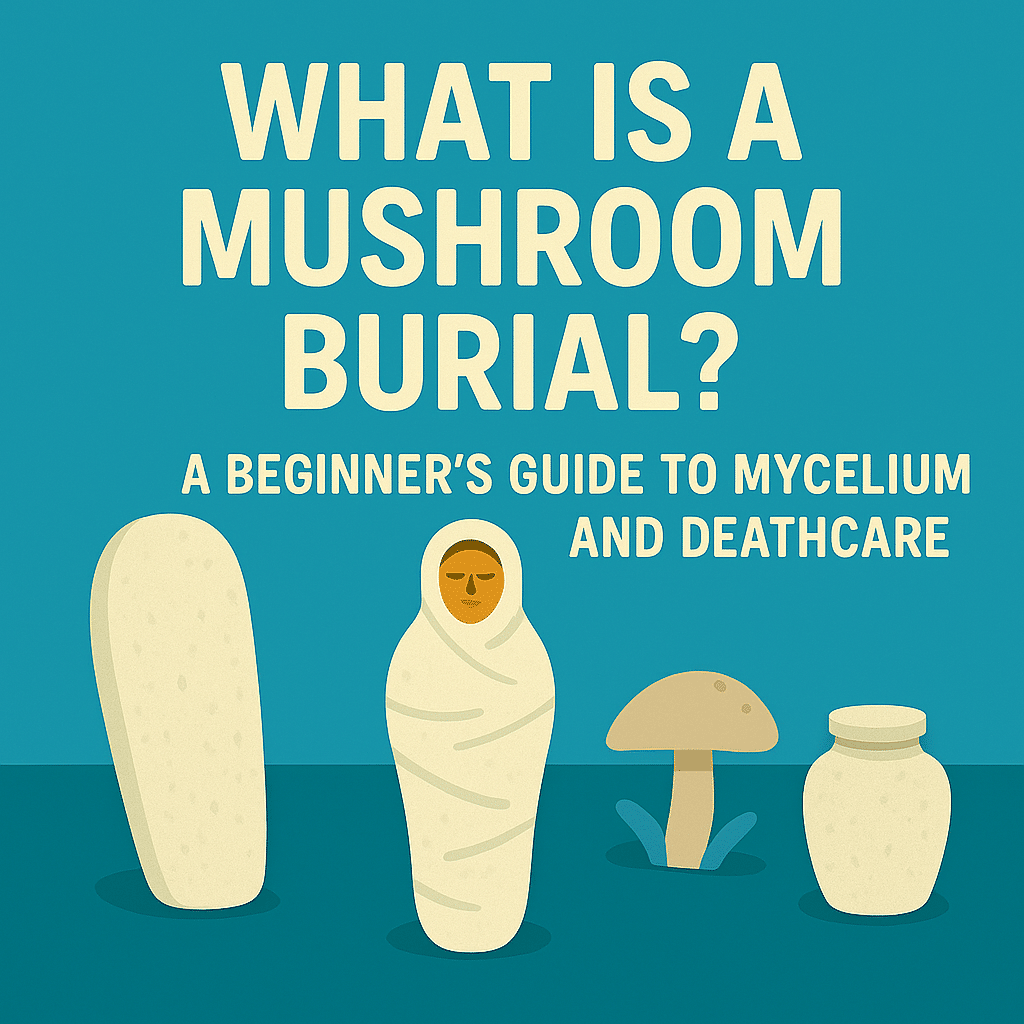For many people, traditional burials don’t feel aligned with their values. The casket, the vault, the chemicals — it all feels unnatural. That’s where mushroom burial comes in. Quietly but powerfully, this innovative option is reshaping how we think about our return to the earth.
If you’ve heard the term and wondered what it actually means, you’re not alone. This guide walks you through the basics, from the science of mycelium to the emotional and environmental reasons people are choosing mushroom-based burial products.
What Is a Mushroom Burial?
A mushroom burial is an eco-conscious end-of-life practice that uses mycelium, the root-like structure of fungi, to help decompose the body naturally and enrich the surrounding soil. Instead of a metal or hardwood coffin, the body is placed in a coffin, shroud, or vessel made from living or cured mycelium.
The fungi continue to grow in the soil, feeding on organic material and breaking it down into nutrients. The result is a burial process that supports new life rather than halting it.
It’s Not Just a Symbol
Mushrooms have long been associated with decay and renewal. In mushroom burial, that symbolism becomes a biological reality. Mycelium not only breaks down the body but also helps neutralize toxins and restore balance to the ecosystem.
What Products Are Used?
There are a few common types of mushroom burial products:
-
Mycelium Coffins – Shaped like traditional caskets but made from organic waste and mycelium. These can break down in as little as 30 to 45 days.
-
Mushroom Burial Shrouds – Flexible wraps made from biodegradable material, sometimes infused with spores or designed to host mycelium growth.
-
Mycelium Urns – Designed to hold cremated remains while helping enrich the soil as they break down.
Some companies offer pet-sized options, custom colors, and products that are suitable for home storage if pre-purchased.
What Is Mycelium, Exactly?
Mycelium is the underground part of fungi. Think of it as a vast, interconnected network that feeds on organic matter and helps trees and plants communicate with each other. It is the largest organism on Earth and one of nature’s most effective recyclers.
When used in burial, mycelium’s ability to break down complex materials like wood, flesh, and toxins makes it an ideal partner for a clean, respectful return to the soil.
How Is It Made?
Most mushroom burial products are grown, not manufactured. Fungi are cultivated in molds filled with agricultural byproducts like hemp or sawdust. As the mycelium grows, it binds everything together into a solid form. Once the shape is complete, it is typically dried or heat-treated to stop further growth until burial.
This process uses little energy, requires no synthetic materials, and leaves behind no waste.
Why Are People Choosing Mushroom Burial?
Environmental Reasons
Traditional burial and cremation practices are resource-intensive. Between embalming fluid, cement vaults, and high-energy cremations, the environmental toll is significant. Mushroom burial offers an alternative that is carbon-negative, non-toxic, and completely biodegradable.
Some coffins even absorb carbon dioxide during their growth and burial, similar to planting a tree.
Emotional and Philosophical Reasons
Mushroom burial appeals to those who view death as part of life, not separate from it. It creates a tangible link between the person who has died and the life that continues in their absence. Instead of isolating the body in a sealed box, it encourages a return to nature that feels more holistic, spiritual, and healing.
Financial Reasons
While still relatively new, mushroom burial products are often less expensive than traditional hardwood caskets or cremation urns. Many options range from $500 to $2,000, depending on size and style.
Is It Legal?
Yes, mushroom burial products are legal to purchase. However, their use depends on your burial location. These products are best suited for:
-
Green or natural burial cemeteries
-
Private property (in states where home burial is legal)
-
Cemeteries with flexible policies on vaults and embalming
You’ll need to confirm with your chosen cemetery that they accept biodegradable coffins or shrouds and allow vault-free burial.
Is It a Good Fit for Religious Traditions?
Many mushroom burial products meet the requirements of Jewish burial law, including being biodegradable and free of metal or synthetic components. Other religious and spiritual traditions that emphasize simplicity, environmental care, or body-to-earth rituals may also find this method aligned with their values.
What’s Next?
Mushroom burial is still a relatively new concept, but it is growing quickly. As more cemeteries accept green burial practices and more families seek alternatives to conventional deathcare, fungi are finding their way into more conversations and more final resting places.
If you have feedback, questions, or ideas for future articles or Information Hubs, please contact us. Your insights help us create valuable content.


